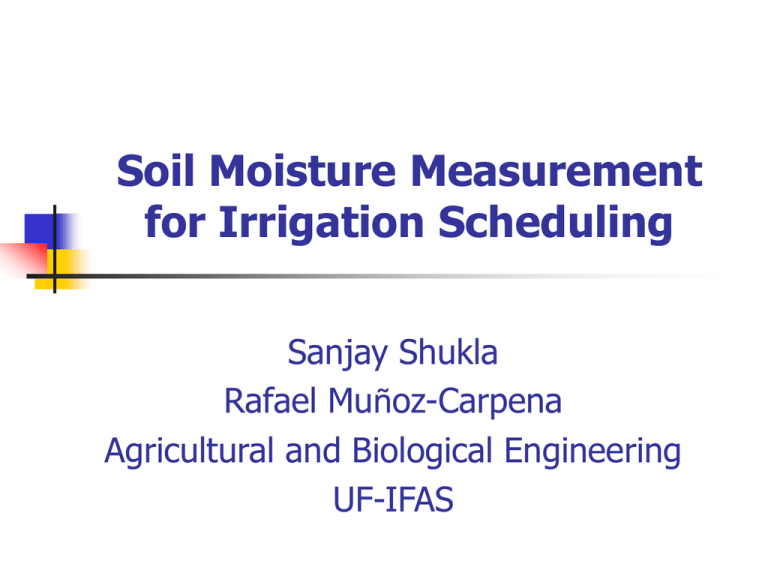Soil Moisture Measurement for Irrigation Scheduling
advertisement

Soil Moisture Measurement for Irrigation Scheduling Sanjay Shukla Rafael Muñoz-Carpena Agricultural and Biological Engineering UF-IFAS Plant Water Demands Evapotranspiration (ET) is defined as the amount of water lost from the ground due to processes: a)Evaporation: is the physical process by which a liquid (or solid) changes into a gas. It takes place both from water surfaces as well as wet soils and vegetation. b) Transpiration: is the process by which the plant transports water from the roots to the leaf stomata. Quantification of Water Demands To estimate water demands we have basically two kinds of methods for ET estimation: a)Hydrological methods: Is the physical process by which a liquid (or solid) changes into a gas. It takes place both from water surfaces as well as wet soils and vegetation. b) Micrometeorological methods: They are based in the fact that transportation and evaporation are linked to atmospheric conditions, what has been called the “soil-plant-atmosphere continuum”. There are also several methods for getting transpiration estimates Hydrological Methods This refers to water balance (budget) methods: RO: Runoff P: Precipitation F: Soil Infiltration D: Deep percolation Dq= Soil moisture Atmosphere Soil Aquifer If RO=0 and all but ET are measured we can estimate ET Micrometeorological methods The atmospheric conditions dictate the amount of water that can potentially leave the soil surface. Basically there are three classes of methods: a) Radiation based methods. Sun energy is the motor for water evaporation/transpiration. b) Aerodynamic or transport based. Evaporation from a surface increases as we move the water away (wind) as it is evaporated. This is related to “vapor deficit”. c) Combination: both radiation and aerodynamic terms. Radiation methods . SPACE SPACE ATMOSPHERE OCEAN/LAND Incoming solar radiation Outgoing earth radiation Short wave Long wave Irrigation vs. Plant Water Demands We must remember that the final amount of water to give to the crop is not just the water demands. It has to include also: a)Losses of the water distribution system b) Counteract differences in water distribution (irrigation uniformity or efficiency) c) Leaching requirements for saline (salty) environments d) Other water that has entered the soil (namely rainfall) e)Other losses/restrictions (soil, system, yield potential etc). Finally we should always keep in mind that the amount will change with time based on plant phenology (development), weather conditions, and soil. Irrigation Scheduling Appropriate water at appropriate time Crop need, soil properties, and weather condition Different methods Experience Calendar method (0.8 in every 4th day) Meteorological (weather based ET estimation based on weather) Dynamic water balance – water budget Soil water measurement based irrigation Soil Moisture Scheduling Self-adjusting: appropriate water at appropriate time Opportunity for reduction in water losses and chemical leaching since soil is kept below field capacity and deep drainage is reduced



